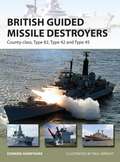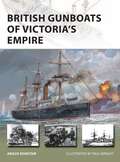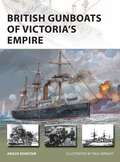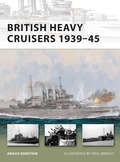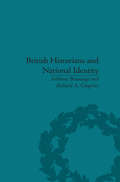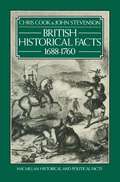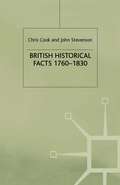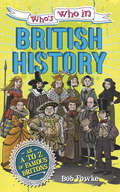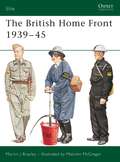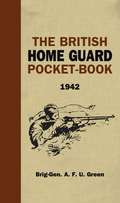- Table View
- List View
The British Government and the Falkland Islands, 1974-79 (Security, Conflict and Cooperation in the Contemporary World)
by A. DonaghyDrawing on recently declassified government files, private papers and interviews, this book argues that through a combination of preventative diplomacy and robust defence planning, the Labour government of 1974-79 succeeded in maintaining peace, avoiding the fate of its Tory successors.
British Grand Strategy in the Age of American Hegemony
by William D. JamesIs the United Kingdom capable of grand strategy? Common wisdom suggests otherwise. Some think it implausible amid the maelstrom of domestic politics, while others believe the UK lacks the necessary autonomy, as a cog in the US-led order. British Grand Strategy in the Age of American Hegemony challenges these claims. William D. James contends that grand strategy is an unavoidable part of governing. Grand strategy is the highest level of national security decision-making, encompassing judgements over a state's overarching objectives and interests, as well as its security environment and resource base. Getting these decisions 'right' is vital in moments of geopolitical flux. Employing several historical case studies between 1940-2003 and marshalling a host of primary sources, James argues that British politicians and officials have thought in grand strategic terms under American hegemony - even if they do not realise or admit to this. He also demonstrates that the role of allies in shaping British grand strategy has been overstated. Finally, James highlights the conditions under which domestic political actors can influence grand strategic decision-making. Written for practitioners as well as scholars, the book concludes with several policy recommendations at this inflection point in British history.
British Grand Strategy in the Age of American Hegemony
by William D. JamesIs the United Kingdom capable of grand strategy? Common wisdom suggests otherwise. Some think it implausible amid the maelstrom of domestic politics, while others believe the UK lacks the necessary autonomy, as a cog in the US-led order. British Grand Strategy in the Age of American Hegemony challenges these claims. William D. James contends that grand strategy is an unavoidable part of governing. Grand strategy is the highest level of national security decision-making, encompassing judgements over a state's overarching objectives and interests, as well as its security environment and resource base. Getting these decisions 'right' is vital in moments of geopolitical flux. Employing several historical case studies between 1940-2003 and marshalling a host of primary sources, James argues that British politicians and officials have thought in grand strategic terms under American hegemony - even if they do not realise or admit to this. He also demonstrates that the role of allies in shaping British grand strategy has been overstated. Finally, James highlights the conditions under which domestic political actors can influence grand strategic decision-making. Written for practitioners as well as scholars, the book concludes with several policy recommendations at this inflection point in British history.
British Guided Missile Destroyers: County-class, Type 82, Type 42 and Type 45 (New Vanguard #234)
by Edward HampshireIn the years after World War II, new guided missile technology offered surface ships the chance to destroy airborne threats from afar, thereby preserving their role in naval warfare. This book examines the technology and combat performance of Britain's guided missile destroyers over half a century.Uniquely among modern destroyers, three of these classes have been tested in battle against the aircraft and missiles of another modern navy - in the Falklands War - as well as being deployed during the Gulf War. Written by an expert on British naval technology, this book assess the changing technology of the Royal Navy's destroyers over half a century, including an examination of the Royal Navy's newest and most capable warship, the Type 45.
British Guided Missile Destroyers: County-class, Type 82, Type 42 and Type 45 (New Vanguard)
by Paul Wright Edward HampshireIn the years after World War II, new guided missile technology offered surface ships the chance to destroy airborne threats from afar, thereby preserving their role in naval warfare. This book examines the technology and combat performance of Britain's guided missile destroyers over half a century.Uniquely among modern destroyers, three of these classes have been tested in battle against the aircraft and missiles of another modern navy - in the Falklands War - as well as being deployed during the Gulf War. Written by an expert on British naval technology, this book assess the changing technology of the Royal Navy's destroyers over half a century, including an examination of the Royal Navy's newest and most capable warship, the Type 45.
British Gunboats of Victoria's Empire (New Vanguard)
by Angus KonstamA beautifully illustrated history of the iconic ocean-going gunboats of British 'gunboat diplomacy', the hundreds of little warships that for 50 years demonstrated the power of the Royal Navy worldwide, and which maintained and enforced the rule of the British Empire at its peak.In recent years the phrase 'gunboat diplomacy' has been used to describe the crude use of naval power to bully or coerce a weaker nation. During the reign of Queen Victoria, 'gunboat diplomacy' was viewed very differently. It was the use of a very limited naval force to encourage global stability and to protect British overseas trade. This very subtle use of naval power was a vital cornerstone of the Pax Britannica. Between the Crimean War (1854–56) and 1904, when the gunboat era came to an abrupt end, the Royal Navy's ocean-going gunboats underpinned Britain's position as a global power and fulfilled the country's role as a 'global policeman'.Created during the Crimean War, these gunboats first saw action in China. However, they were also used to hunt down pirates in the coasts and rivers of Borneo and Malaya, to quell insurrections and revolts in the Caribbean or hunt slavers off the African coast. The first gunboats were designed for service in the Crimean War, but during the 1860s a new generation of ships began entering service – vessels designed specifically to fulfill this global policing role. Better-designed gunboats followed, but by the 1880s, the need for them was waning . The axe finally fell in 1904 when Admiral 'Jackie' Fisher brought the gunboat era to an end in order to help fund the new age of the dreadnought. This exciting New Vanguard title describes the rise and fall of the gunboat, the appearance and capability of these vital warships, and what life was like on board. It also examines key actions they were involved in.
British Gunboats of Victoria's Empire (New Vanguard)
by Angus KonstamA beautifully illustrated history of the iconic ocean-going gunboats of British 'gunboat diplomacy', the hundreds of little warships that for 50 years demonstrated the power of the Royal Navy worldwide, and which maintained and enforced the rule of the British Empire at its peak.In recent years the phrase 'gunboat diplomacy' has been used to describe the crude use of naval power to bully or coerce a weaker nation. During the reign of Queen Victoria, 'gunboat diplomacy' was viewed very differently. It was the use of a very limited naval force to encourage global stability and to protect British overseas trade. This very subtle use of naval power was a vital cornerstone of the Pax Britannica. Between the Crimean War (1854–56) and 1904, when the gunboat era came to an abrupt end, the Royal Navy's ocean-going gunboats underpinned Britain's position as a global power and fulfilled the country's role as a 'global policeman'.Created during the Crimean War, these gunboats first saw action in China. However, they were also used to hunt down pirates in the coasts and rivers of Borneo and Malaya, to quell insurrections and revolts in the Caribbean or hunt slavers off the African coast. The first gunboats were designed for service in the Crimean War, but during the 1860s a new generation of ships began entering service – vessels designed specifically to fulfill this global policing role. Better-designed gunboats followed, but by the 1880s, the need for them was waning . The axe finally fell in 1904 when Admiral 'Jackie' Fisher brought the gunboat era to an end in order to help fund the new age of the dreadnought. This exciting New Vanguard title describes the rise and fall of the gunboat, the appearance and capability of these vital warships, and what life was like on board. It also examines key actions they were involved in.
British Heavy Cruisers 1939–45 (New Vanguard #190)
by Angus Konstam Mr Paul WrightThe idea of a heavy cruiser emerged in the aftermath of World War I, and was closely linked to the limits set by the inter-war Washington Naval Treaty. The pre-World War I concept of armoured cruisers had been abandoned, but in their stead the Admiralty saw a place for powerful cruisers, able to patrol the sea lanes of the British Empire, and which were well-armed enough that they could destroy enemy commerce cruisers. The result was a group of British warships, known as the 'Washington Treaty Cruisers', that did everything the Admiralty wanted, but which conformed to the limits imposed by the treaty. These impressive cruisers were high-sided, spacious and stately – perfect peacetime ambassadors for British power. In war they also packed a considerable punch. During World War II the Royal Navy's thirteen heavy cruisers saw service in every theatre of the war, whether facing the Bismarck in the North Atlantic or enduring kamikaze attacks in the Pacific.
British Heavy Cruisers 1939–45 (New Vanguard)
by Paul Wright Angus KonstamThe idea of a heavy cruiser emerged in the aftermath of World War I, and was closely linked to the limits set by the inter-war Washington Naval Treaty. The pre-World War I concept of armoured cruisers had been abandoned, but in their stead the Admiralty saw a place for powerful cruisers, able to patrol the sea lanes of the British Empire, and which were well-armed enough that they could destroy enemy commerce cruisers. The result was a group of British warships, known as the 'Washington Treaty Cruisers', that did everything the Admiralty wanted, but which conformed to the limits imposed by the treaty. These impressive cruisers were high-sided, spacious and stately – perfect peacetime ambassadors for British power. In war they also packed a considerable punch. During World War II the Royal Navy's thirteen heavy cruisers saw service in every theatre of the war, whether facing the Bismarck in the North Atlantic or enduring kamikaze attacks in the Pacific.
British Historians and National Identity: From Hume to Churchill
by Anthony Leon BrundageTwo eminent scholars of historiography examine the concept of national identity through the key multi-volume histories of the last two hundred years. Starting with Hume’s History of England (1754–62), they explore the work of British historians whose work had a popular readership and an influence on succeeding generations of British children.
British Historians and National Identity: From Hume to Churchill
by Anthony Leon BrundageTwo eminent scholars of historiography examine the concept of national identity through the key multi-volume histories of the last two hundred years. Starting with Hume’s History of England (1754–62), they explore the work of British historians whose work had a popular readership and an influence on succeeding generations of British children.
British Historical Facts: 1688-1760 (Palgrave Historical and Political Facts)
by Chris Cook John StevensonThe latest volume in this series covers the period in British history from the Glorious Revolution of 1688 to the accession of George III in 1760. Chapters are included on administration, ministerial biographies, Parliament, defence and treaties, and the expansion of the Empire.
British Historical Facts, 1760-1830 (Palgrave Historical and Political Facts)
by C. Cook J. StevensonBritish Historical Facts, 1830-1900 (Palgrave Historical and Political Facts)
by Chris Cook Brendan KeithBritish Historical Facts, 1830-1900 comes as an original and pioneering attempt to provide within a single volume a comprehensive yet readily accessible source-book of facts and figures on the Victorian period.
British Historical Fiction before Scott (Palgrave Studies in the Enlightenment, Romanticism and Cultures of Print)
by A. StevensIn the half century before Walter Scott's Waverley , dozens of popular novelists produced historical fictions for circulating libraries. This book examines eighty-five popular historical novels published between 1762 and 1813, looking at how the conventions of the genre developed through a process of imitation and experimentation.
British History: British History (library Ebook) (Who's Who in)
by Robert Fowke'Who's Who in British History' contains biographies of 250 of the most important people in British history. Written in an informal, friendly style, the book provides essential information about their lives. Aimed at children of 8-12 years, the book is easy to use, with cross references, a glossary and an index. The text is interspersed with appealing cartoon-style illustrations.Includes a huge range of biographies from kings and queens, artists, saints, writers, inventors, sporting heroes, explorers, politicians and statesment, philanthropists, pilots, rebels and villains, pretenders to the throne to teachers, warriors and fashion victims.Expert consultant: Dr Miles Taylor of King's College, University of London.
British History, 1660-1832: National Identity and Local Culture (British Studies Series)
by Alexander MurdochThis is an interpretative study of the idea of Britain, examining the transformation of a sectarian concept into an imperial ideology forged during a period of sustained warfare in Europe and ever-expanding areas beyond Europe during the second half of the Eighteenth century. It seeks to examine constitutional history from a non-Anglocentric perspective and to relocate it to historiographical developments in Social History and the History of Ideas. Based on more than 25 years of research, it seeks to examine critically a concept which increasingly has come under public debate during the past decade.
British History For Dummies
by Seán LangThis book is a riotous, irreverent account of the people and events that have shaped Britain. Always getting those kings and queens confused? Never sure what happened when? Then you need this book. Inside you'll find rip-roaring stories of power-mad kings, executions, invasions, high treason, global empire building, and forbidden love — not bad for a nation of stiff upper lips! Revised and expanded to include the historical parliamentary elections of 2010 and the British mission in Afghanistan Accompanied by access to a timeline and 'Who's Who in British History' section on dummies.com This new edition contains an 8-page color insert so you can see who, what and where the ensuing historical action takes place
British History For Dummies
by Seán LangHistory is always a popular subject and British history has created some of the most lively and fascinating stories there are! Britain as we know it today has been shaped by centuries of political turmoil between state and church, as well as international conflicts, making its history a fascinating insight into how modern Britain has emerged. For this special, hardback edition of British History For Dummies, we’ve added over 100 black and white and colour photos for an even more explosive experience of British history. British History For Dummies Illustrated Edition: British history is still a major topic of interest, emphasised by the continual TV coverage and documentaries Inside you’ll find rip-roaring stories of power-mad kings, executions, invasions, high treason, global empire-building and forbidden love- not bad for a nation of stiff upper lips! Includes fascinating information in the fun For Dummies style- from the Stone Age right through to modern day Britain and everything in between! Provides the ultimate British history experience and the hardback format with over 100 illustrations make it the perfect gift for amateur historians
British History For Dummies
by Seán LangHistory is always a popular subject and British history has created some of the most lively and fascinating stories there are! Britain as we know it today has been shaped by centuries of political turmoil between state and church, as well as international conflicts, making its history a fascinating insight into how modern Britain has emerged. For this special, hardback edition of British History For Dummies, we’ve added over 100 black and white and colour photos for an even more explosive experience of British history. British History For Dummies Illustrated Edition: British history is still a major topic of interest, emphasised by the continual TV coverage and documentaries Inside you’ll find rip-roaring stories of power-mad kings, executions, invasions, high treason, global empire-building and forbidden love- not bad for a nation of stiff upper lips! Includes fascinating information in the fun For Dummies style- from the Stone Age right through to modern day Britain and everything in between! Provides the ultimate British history experience and the hardback format with over 100 illustrations make it the perfect gift for amateur historians
British History For Dummies
by Seán LangThis book is a riotous, irreverent account of the people and events that have shaped Britain. Always getting those kings and queens confused? Never sure what happened when? Then you need this book. Inside you'll find rip-roaring stories of power-mad kings, executions, invasions, high treason, global empire building, and forbidden love — not bad for a nation of stiff upper lips! Revised and expanded to include the historical parliamentary elections of 2010 and the British mission in Afghanistan Accompanied by access to a timeline and 'Who's Who in British History' section on dummies.com This new edition contains an 8-page color insert so you can see who, what and where the ensuing historical action takes place
The British Home Front 1939–45 (Elite)
by Martin Brayley Malcolm McGregorThe population of Britain was mobilized to support the war effort on a scale unseen in any other Western democracy – or in Nazi Germany. They endured long working shifts, shortages of food and all other goods, and complete government control of their daily lives. Most men and women were conscripted or volunteered for additional tasks outside their formal working hours. Under the air raids that destroyed the centres of many towns and made about 2 million homeless, more than 60,000 civilians were killed and 86,000 seriously injured. This fascinating illustrated summary of wartime life, and the organizations that served on the Home front, is a striking record of endurance and sacrifice.
The British Home Front 1939–45 (Elite #109)
by Martin Brayley Malcolm McGregorThe population of Britain was mobilized to support the war effort on a scale unseen in any other Western democracy – or in Nazi Germany. They endured long working shifts, shortages of food and all other goods, and complete government control of their daily lives. Most men and women were conscripted or volunteered for additional tasks outside their formal working hours. Under the air raids that destroyed the centres of many towns and made about 2 million homeless, more than 60,000 civilians were killed and 86,000 seriously injured. This fascinating illustrated summary of wartime life, and the organizations that served on the Home front, is a striking record of endurance and sacrifice.
The British Home Guard Pocketbook
by A.F.U. GreenThe Home Guards are an attacking force lying in wait for, and ready to destroy, and enemy who dares to set foot on out shores.' The Home Guard has been immortalised in British culture in the TV series Dad's Army. Formed by men not eligible for active service – too old, too young, in reserved occupations vital to the war effort – who were expected to resist a German invasion with any resources they had to hand, the Home Guard is the embodiment of plucky British resolve against the odds. The Home Guard Pocket-Book evokes this spirit. Written by Brig-Gen Green, commanding 4th battalion, Sussex Home Guard and Training Adviser for the Sussex Zone, this book is based on his experience and, in his own words, 'is the result of my ransacking the dusty pigeon-holes of memory and the condensation of many books, official instructions and writings'. Its tone is informal and colloquial, such as: 'March discipline. Troops will always march off the parade ground at the Slope. As soon as this has been done the order "March at Ease" should be given. When marching at ease the rifle may be carried in any way a soldier fancies.' Nevertheless, the book is full of sound advice on training, organisation and discipline, fire arms, reconnaissance and field engineering, the responsibilities of the Group Pigeon Officer, the proper position to adopt for surviving a dive bomb attack, and how to set a trap for an unwary advancing German cyclist!



